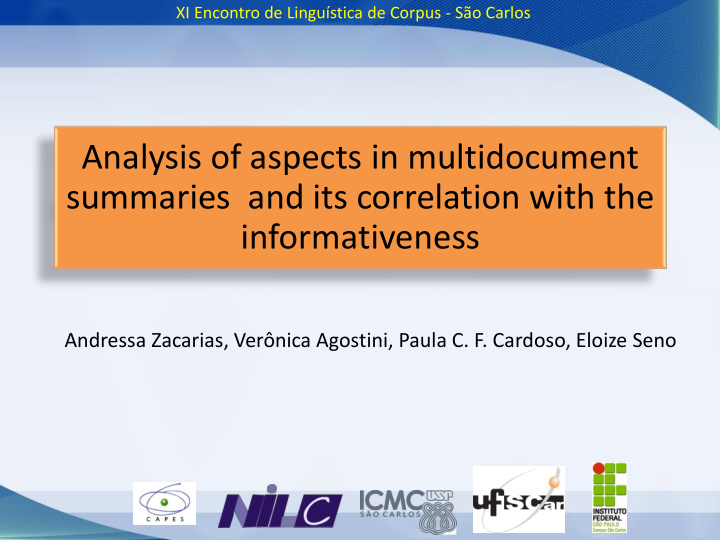



XI Encontro de Linguística de Corpus - São Carlos Analysis of aspects in multidocument summaries and its correlation with the informativeness Andressa Zacarias, Verônica Agostini, Paula C. F. Cardoso, Eloize Seno
Schedule • Motivation • Purposes of this work • Methodology • Results • Future work • Main references 2
Motivation • Multi-document summarization User/Reader 3
Motivation • Guided summarization task – It is guided by a list of important aspects whose information should be contained in the generated summary (Hu and Ji, 2011) – TAC 2010 • 5 categories: Accidents, Attacks, Health, Resources and Trials • Example Accidents What When Where Why Who affected Damages 4 countermeasures
Motivation • Guided summarization task – Two purposes (Owczarzak and Dang, 2011) • It creates a more focused target for automatic summarizers, neutralizing human variance and pointing to concrete types of information the reader requires • It provides a detailed diagnostic tool to analyze the automatic summaries – A summary with all aspects is ideal in that it (Zhang et al., 2011 ) • Addresses specific and semantically structured user need, and • Achieves good coherence on the content level. 5
Purposes of this work • Evaluate the automatic summaries are keeping the aspects • The relation among the aspects and ROUGE measure (Lin, 2004) 6
Methodology • Choose a sample of CSTNews corpus (Cardoso et al., 2011) – Each cluster has 2 to 3 texts in Brazilian Portuguese – Single-document and multi-document summaries • Sample: 4 texts related to events that involved police • Summarizer system: CSTSUmm (Jorge and Pardo, 2010) Number of clusters for each category Politics World 11 14 Science 1 Sports 10 Money Daily news 13 1 7
Methodology • The annotation – 4 annotators with computational linguistics knowledge – The original list of TAC and new aspects were created 8
Aspects Aspect Description What What happened Who People or entity involved in the main event When Date, time, other temporal placement markers Where Physical location Why Reasons for the event How How the event happened Perpetrator Individual or groups responsible for the event Who affected Individuals negatively affected What affected * Physical structures negatively affected History * History related to the event * aspects created by annotators 9
Example [ Terminou a rebelião de presos no Centro de Custódia de Presos de Justiça (CCPJ), em São Luís, no começo da tarde desta quarta-feira (17). ] WHAT/WHERE/WHEN [ O motim começou durante a festa do Dia das Crianças. ]HISTORY [ Depois que os presos entregaram o revólver usado para dar início ao motim, a Tropa de Choque da Polícia Militar entrou no presídio e liberou os 30 reféns - sendo 16 crianças. ]HOW/WHO-AFFECTED [ Alguns menores saíram desmaiados e foram conduzidos para o atendimento médico. ]DAMAGES [ Quatro pessoas teriam ficado feridas. ]DAMAGES 10
Results • Automatic x Reference summaries – Frequency of aspects 11
Results • Automatic x Reference summaries – ROUGE evaluation Recall Precision F-Measure 0.58772 0.58772 0.58772 C11 0.58491 0.45588 0.51240 C37 0.72414 0.51852 0.60432 C39 0.66379 0.53103 0.59003 C45 – Total of aspects per summary Reference Automatic 16 9 C11 8 5 C37 6 5 C39 7 6 C45 12
Results • Automatic x Reference summaries – ROUGE evaluation Recall Precision F-Measure 0.58772 0.58772 0.58772 C11 0.58491 0.45588 0.51240 C37 0.72414 0.51852 0.60432 C39 0.66379 0.53103 0.59003 C45 – Total of aspects per summary Reference Automatic 16 9 C11 8 5 C37 6 5 C39 7 6 C45 13
Final remarks • How much more aspects of reference summary are present in automatic summaries, we will have more informativeness • Future: extending the notation for the rest of CSTNews 14
Main references Cardoso, P.C.F.; Maziero, E.G.; Jorge, M.L.C.; Seno, E.M.R.; Di Felippo, A.; Rino, L.H.M.; Nunes, M.G.V.; Pardo, T.A.S. (2011). CSTNews - A Discourse-Annotated Corpus for Single and Multi- Document Summarization of News Texts in Brazilian Portuguese.In the Proceedings of the 3rd RST Brazilian Meeting , pp. 1-18.October 26, Cuiabá-MT, Brazil. Jorge, M.L.C. e Pardo, T.A.S. (2010). Experiments with CST-based Multidocument Summarization. In the Proceedings of the ACL Workshop TextGraphs-5: Graph-based Methods for Natural Language Processing , pp. 74-82. July 16, Uppsala/Sweden. Lin, C. (2004). ROUGE: a Package for Automatic Evaluation of Summaries. In the Proceedings of the Workshop on Text Summarization Branches Out (WAS 2004), Barcelona, Spain. Owczarzak, K. e Dang, H. (2011). Who wrote What Where: Analyzing the content of human and automatic summaries. In the Proceedings of the Workshop on Automatic Summarization for Different Genres, Media, and Languages , pp. 25-32.Junho, Portland, Oregon. Zhang, R., Li, W., Gao, D. (2011). Generating Coherent Summaries with Textual Aspects. In Proceedingsof AAAI 2012 . 15
XI Encontro de Linguística de Corpus - São Carlos Analysis of aspects in multidocument summaries and its correlation with the informativeness Andressa Zacarias, Verônica Agostini, Paula C. F. Cardoso, Eloize Seno
Recommend
More recommend